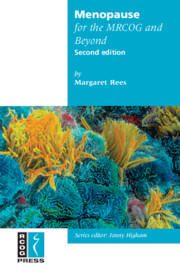Book contents
- Frontmatter
- Contents
- Preface
- Abbreviations
- 1 Definitions and controversies
- 2 Explaining risk
- 3 Systemic hormone replacement therapy
- 4 Non-HRT options for osteoporosis
- 5 Diet and lifestyle
- 6 Alternative and complementary therapies
- 7 Vasomotor symptoms, urogenital and sexual problems
- 8 Osteoporosis and autoimmune arthritis
- 9 Breast disease
- 10 Benign and malignant gynaecological disease
- 11 Premature menopause
- 12 Women with concomitant medical conditions
- Index
1 - Definitions and controversies
Published online by Cambridge University Press: 05 July 2014
- Frontmatter
- Contents
- Preface
- Abbreviations
- 1 Definitions and controversies
- 2 Explaining risk
- 3 Systemic hormone replacement therapy
- 4 Non-HRT options for osteoporosis
- 5 Diet and lifestyle
- 6 Alternative and complementary therapies
- 7 Vasomotor symptoms, urogenital and sexual problems
- 8 Osteoporosis and autoimmune arthritis
- 9 Breast disease
- 10 Benign and malignant gynaecological disease
- 11 Premature menopause
- 12 Women with concomitant medical conditions
- Index
Summary
Introduction
The management of the menopausal and postmenopausal woman is an area where gynaecologists also become physicians, dealing not only with the consequences of ovarian failure but also of ageing. Estrogen deficiency affects many organ systems and a holistic approach is required. Postmenopausal health is a growing area of medicine as populations are ageing. The average age of the menopause, or last menstrual period, is 52 years. Current smoking, lower educational attainment, being separated/widowed/divorced, unemployment, Down syndrome and a history of heart disease are associated with earlier natural menopause, while parity, prior use of oral contraceptives and Japanese race/ethnicity are associated with later age at natural menopause.
Definitions
Various definitions are in use and are detailed in Box 1.
Stages of reproductive ageing
A staging system that uses the final or last menstrual period as the key event to describe reproductive ageing was proposed by the Stages of Reproductive Aging Workshop. In this system, five stages precede and two stages follow the final menstrual period. Stages –5 to –3 encompass the reproductive interval, stages –2 and –1 are the menopausal transition and stages 1 and 2 are the postmenopause. After menarche (stage –5), it usually takes several years for regular menstrual cycles to become established. Menstrual periods should then occur every 21–35 days for a number of years (stages –4 and –3).
- Type
- Chapter
- Information
- Menopause for the MRCOG and Beyond , pp. 1 - 8Publisher: Cambridge University PressPrint publication year: 2008

